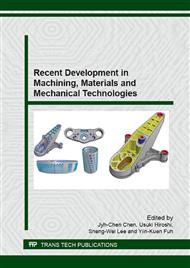p.416
p.422
p.428
p.434
p.440
p.446
p.450
p.456
p.461
Mechanical Properties Evaluation of Metal Components Repaired by Direct Metal Lamination
Abstract:
Direct metal lamination using arc discharge was applied to the repair of metal components such as metallic parts, dies and molds by adding equivalent metal to them. In this method, a heat-affected zone which has different mechanical properties from the base metal is formed near the laminated metal. This is because the rapid temperature change by welding heat input can cause phase transformation or metallic structure change. Therefore, the mechanical properties of the laminated metal, heat-affected zone and base metal after repair by direct metal lamination need to be explored. In addition, the region which needs to be repaired must be removed in advance because worn and defective parts aren’t adequate as the base for lamination of further layers. Thus, the most suitable removal shape for repair by direct metal lamination was investigated. Finally, the hardness distribution and toughness of the metal components after repair was explored. It was found that the hardness distribution of metal components after repair was uneven. However, the toughness of the heat-affected zone was found to be comparable to those of the laminated metal and the base metal.
Info:
Periodical:
Pages:
440-445
Citation:
Online since:
July 2015
Authors:
Keywords:
Price:
Сopyright:
© 2015 Trans Tech Publications Ltd. All Rights Reserved
Share:
Citation:


